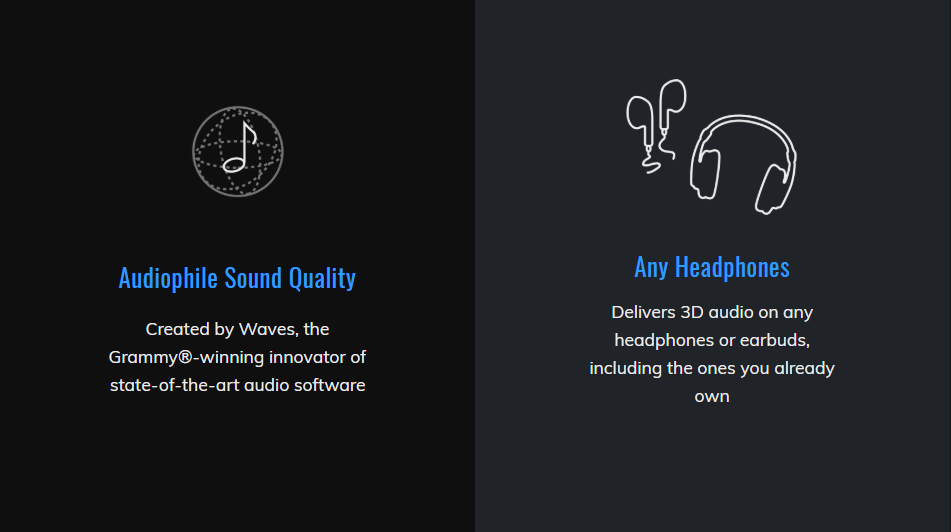Waves NX 3D Headphone Audio Software Review
UPDATE: I've discovered that having this software installed wreaks havoc on Windows 10's audio system, and makes Windows Sonic and Dolby Atmos stop functioning. That's...a little frustrating?
Within a day of using the Waves NX software, I had decided to pay the 10 bucks to upgrade the 30 day free trial to the full version.
I had never heard about Waves NX before last week. My new Dell G5 gaming laptop, a computer that I will eventually get around to reviewing, came with the Waves MaxxAudioPro software, essentially a collection of EQ tools. In the corner of the "dimension" tab was a small link to the Waves NX website.
Waves NX started out as a software package for audio professionals that wanted to have a speaker-like mixing experience on a pair of studio headphones, and they've since adapted it into the consumer version I'm reviewing today.
Okay okay but WHAT IS IT?
It's a true 3D audio solution that combines accurate virtual speaker placements with full 3D head tracking to sell the illusion to your brain and keep the speakers located correctly in the space around you, even when you move.
We turn our heads slightly when we're listening to something, often with little movements that we don't really notice. We shift slightly to hear an interesting detail, or to move our attention to a different part of the screen.
And our brains expect the sound we're hearing to react to this movement.
With traditional headphone listening, and traditional virtual surround algorithms, the channels stay locked in place to our ears. The headphones mimic all the movements our head makes, since they're attached to our head. If you turn all the way to the side, the sound keeps coming from the same fixed points on your head.
This motion problem is the most difficult thing to get around in virtual surround, and it flattens/ruins the effect a little bit. Even if you're not consciously aware of it, the fact that the speakers are fixed in place to your head cheapens the effect for the audio processing centers in your brain.
It makes you aware that the surround isn't "real."
Waves NX fixes this problem with head tracking. It locates your head in 3D space, tracks the little movements that you make, and keeps the virtual speakers fixed in place by translating them around the virtual space to match your head movements. Suddenly, you've gone from having speakers fixed to your head to having "living" speakers in a virtual 3D room.
It's very convincing!
By default, NX uses data from your webcam to track your head's location in full 3D. It doesn't just rotate the room around you for lateral movement, it translates the room in every direction, accounting for every possible tilt or vertical movement of your head. The webcam tracking is pretty good and depending on the buffer setting you use, the CPU hit is minor.
The NX software does a surprisingly good job of tracking my head in 3D space. It also scales up stereo music content quite well, letting it fade gently into the rear channels.
This setup works best on PC and Mac laptops that have a webcam built in, but you can also use it with a desktop webcam. You can even feed in measurements of your head size to make the system more accurate.
Want to get really crazy? Then you can opt for the $99 bluetooth NX head tracker. It's a little device you can clip to the top of your headphones, to track their position in 3D space without a webcam. The webcam tracking is good enough for me that I don't ever see a need for this extra level of precision, but it's out there if you want it.
There's also a non-tracking mode that makes NX operate more or less like other standard virtual surround systems. It's totally fine, but not nearly as magical/cool as the head tracking version.
NX includes three virtual room presets: voice, multimedia, and movie theater. Voice has the least room tone added to it, for a very natural and flat sound with no additional reverb. Multimedia stretches the bounds of the room out a bit, adding some reverb and other room bounce effects. And movie theater goes all-in, simulating a massive room with huge speakers.
It's really fun to lean "closer" to virtual speakers and hear the sound change. It's really fun to turn and grab a cup of coffee and have the sound come from the same direction, naturally.
I tried games, movies, and music and I had a great time with all of them.
I think I even prefer its sense of spatial awareness to other solutions I really enjoy like Dolby Atmos and DTS Headphone X.
The only downside to Waves is that it doesn't support the vertical audio channels that Dolby Atmos and Windows Sonic support. It'll only accept standard 7.1 channel surround tracks, and place them in a flat plane of standard surround speakers around you. There aren't that many games and movies that support vertical data, and the ones that are out there do downscale to standard 7.1, but if that matters to you, you should be aware of it.
Waves NX does exactly what it says it'll do, and does it pretty well, at least in my experience. The webcam tracking isn't perfect, since lighting conditions and quality of your camera can influence it, but it works better than I could ever have reasonably expected.
And hey, the software is 10 bucks. If you have the requisite hardware and you're a virtual surround fan, you owe it to yourself to check it out. It's a bit more convincing at producing true 3D space than any other virtual surround headphones system I've ever used.






